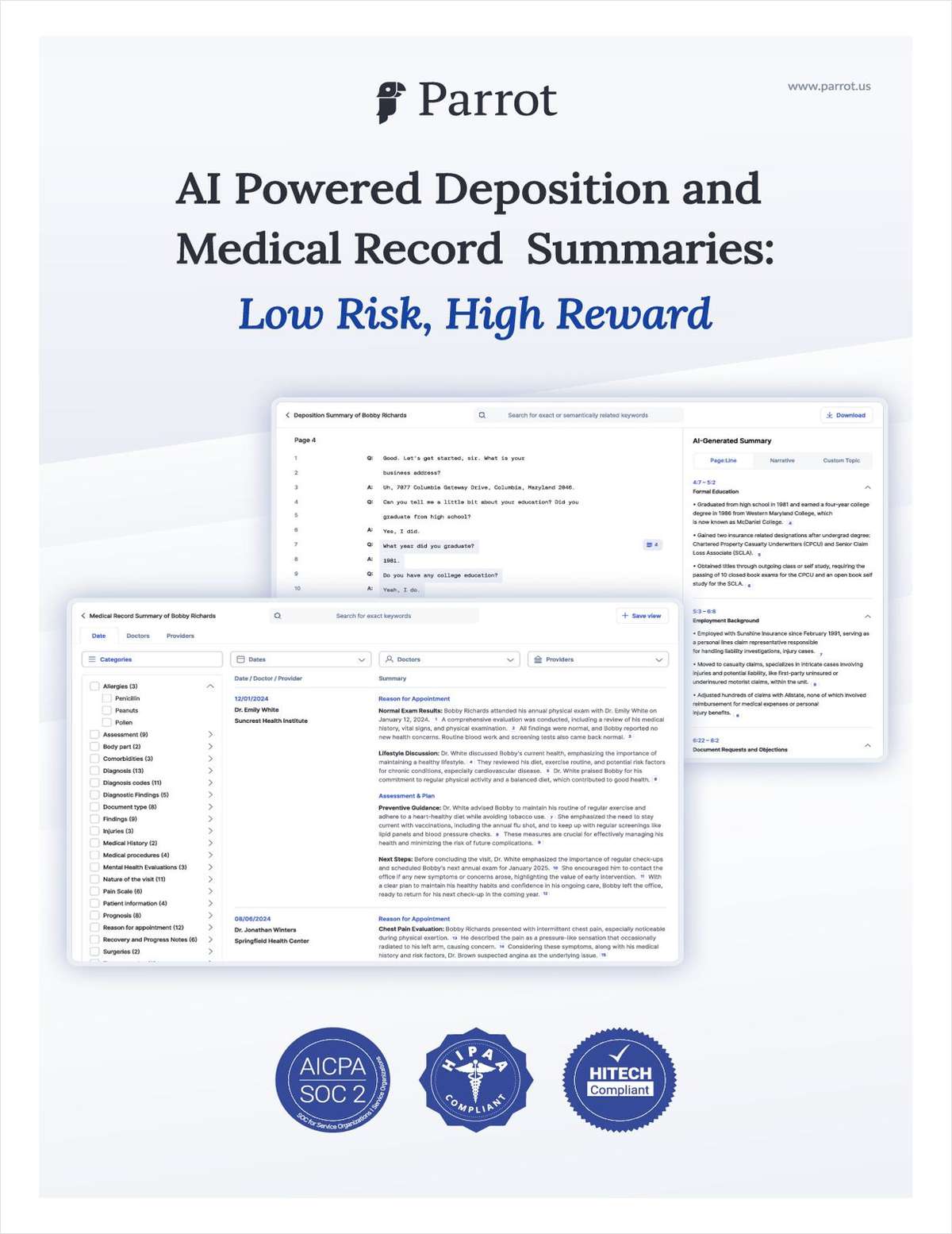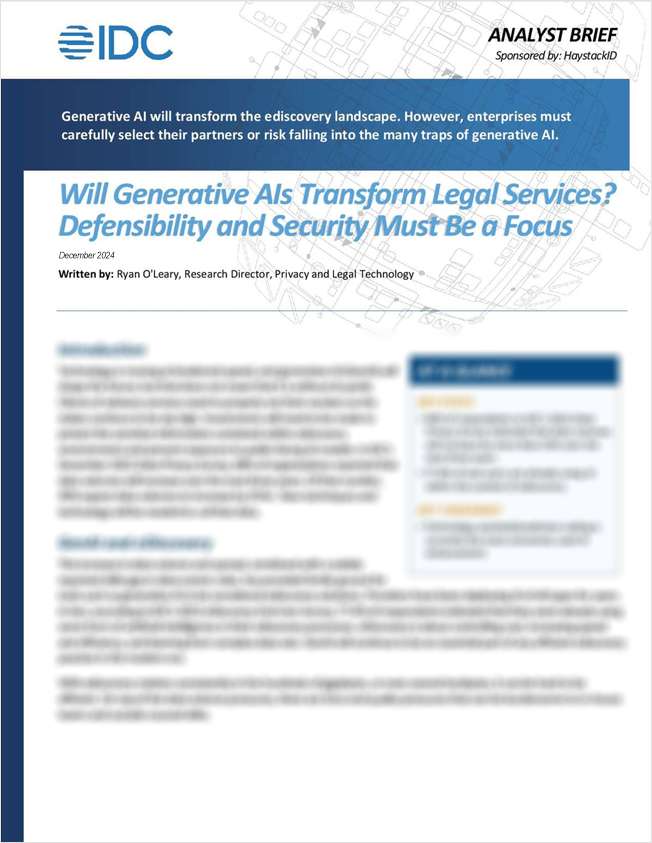 Credit: Sono Creative/Adobe Stock
Credit: Sono Creative/Adobe Stock Are You For Real? Dealing with the Proliferation of Deepfakes
Notwithstanding the significant threats facing companies as a result of deepfake technology, there are several things companies can do to protect themselves and their employees from becoming the victim of a deepfake scam.
June 24, 2024 at 11:22 AM
6 minute read
What You Need to Know
- Along with the emergence of generative AI technologies being used for a variety of constructive purposes, we are also seeing an increase in criminals using these technologies for maleficent purposes.
- "Deepfakes" are created using AI machine learning tools that "train" on real audio/video recordings of an individual and "learn" what those individuals look and sound like.
- We are likely to continue to see these technologies evolve and both companies and individuals falling victim to these schemes.
Imagine a scenario: It's already been a long week, but on Thursday night you receive an invite from your company's CFO asking for an early morning videoconference the next day. While this is an unexpected meeting, your company has been doing more and more meetings over video. On Friday morning you wake up and log on to the videoconference. You recognize everyone in attendance: your CFO and colleagues from your tax and accounts payable departments. The CFO instructs you to send several wires to pay vendor invoices arising from the company's recent retreat. While you find the request a bit strange, you comply because, after all, it is the CFO giving the instructions. You feel more comfortable because your tax colleague confirmed receipt of a W-9 for each vendor, and your accounts payable colleague provided the wire information. Several weeks later, you find out that the CFO never requested the video conference, neither of your colleagues have any recollection of attending such a meeting, and the wires you sent were never authorized.
While this may sound like an elaborate plot from a whodunit film, it is in fact based on a recent, real-life wire fraud scheme perpetrated by a cyber-criminal using "deepfakes" generated by artificial intelligence (AI) technology. In the real scenario, the victim — a financial employee in a multinational company — received an email from the CFO regarding a "secret business transaction." The victim then joined a video conference with the CFO and other corporate executives, who all looked and sounded legitimate. During the meeting the victim was instructed to wire $25.5 million to multiple accounts. About a week later, after calling the corporate office, the victim learned this was all a scam. By then, the $25.5 million were gone.
This content has been archived. It is available through our partners, LexisNexis® and Bloomberg Law.
To view this content, please continue to their sites.
Not a Lexis Subscriber?
Subscribe Now
Not a Bloomberg Law Subscriber?
Subscribe Now
NOT FOR REPRINT
© 2025 ALM Global, LLC, All Rights Reserved. Request academic re-use from www.copyright.com. All other uses, submit a request to [email protected]. For more information visit Asset & Logo Licensing.
You Might Like
View All
African Law Firm Under Investigation For AI-Generated Case References
3 minute read

‘Extremely Disturbing’: AI Firms Face Class Action by ‘Taskers’ Exposed to Traumatic Content
5 minute read
Law Firms Mentioned
Trending Stories
- 1Who Are the Judges Assigned to Challenges to Trump’s Birthright Citizenship Order?
- 2Litigators of the Week: A Directed Verdict Win for Cisco in a West Texas Patent Case
- 3Litigator of the Week Runners-Up and Shout-Outs
- 4Womble Bond Becomes First Firm in UK to Roll Out AI Tool Firmwide
- 5Will a Market Dominated by Small- to Mid-Cap Deals Give Rise to a Dark Horse US Firm in China?
Who Got The Work
J. Brugh Lower of Gibbons has entered an appearance for industrial equipment supplier Devco Corporation in a pending trademark infringement lawsuit. The suit, accusing the defendant of selling knock-off Graco products, was filed Dec. 18 in New Jersey District Court by Rivkin Radler on behalf of Graco Inc. and Graco Minnesota. The case, assigned to U.S. District Judge Zahid N. Quraishi, is 3:24-cv-11294, Graco Inc. et al v. Devco Corporation.
Who Got The Work
Rebecca Maller-Stein and Kent A. Yalowitz of Arnold & Porter Kaye Scholer have entered their appearances for Hanaco Venture Capital and its executives, Lior Prosor and David Frankel, in a pending securities lawsuit. The action, filed on Dec. 24 in New York Southern District Court by Zell, Aron & Co. on behalf of Goldeneye Advisors, accuses the defendants of negligently and fraudulently managing the plaintiff's $1 million investment. The case, assigned to U.S. District Judge Vernon S. Broderick, is 1:24-cv-09918, Goldeneye Advisors, LLC v. Hanaco Venture Capital, Ltd. et al.
Who Got The Work
Attorneys from A&O Shearman has stepped in as defense counsel for Toronto-Dominion Bank and other defendants in a pending securities class action. The suit, filed Dec. 11 in New York Southern District Court by Bleichmar Fonti & Auld, accuses the defendants of concealing the bank's 'pervasive' deficiencies in regards to its compliance with the Bank Secrecy Act and the quality of its anti-money laundering controls. The case, assigned to U.S. District Judge Arun Subramanian, is 1:24-cv-09445, Gonzalez v. The Toronto-Dominion Bank et al.
Who Got The Work
Crown Castle International, a Pennsylvania company providing shared communications infrastructure, has turned to Luke D. Wolf of Gordon Rees Scully Mansukhani to fend off a pending breach-of-contract lawsuit. The court action, filed Nov. 25 in Michigan Eastern District Court by Hooper Hathaway PC on behalf of The Town Residences LLC, accuses Crown Castle of failing to transfer approximately $30,000 in utility payments from T-Mobile in breach of a roof-top lease and assignment agreement. The case, assigned to U.S. District Judge Susan K. Declercq, is 2:24-cv-13131, The Town Residences LLC v. T-Mobile US, Inc. et al.
Who Got The Work
Wilfred P. Coronato and Daniel M. Schwartz of McCarter & English have stepped in as defense counsel to Electrolux Home Products Inc. in a pending product liability lawsuit. The court action, filed Nov. 26 in New York Eastern District Court by Poulos Lopiccolo PC and Nagel Rice LLP on behalf of David Stern, alleges that the defendant's refrigerators’ drawers and shelving repeatedly break and fall apart within months after purchase. The case, assigned to U.S. District Judge Joan M. Azrack, is 2:24-cv-08204, Stern v. Electrolux Home Products, Inc.
Featured Firms
Law Offices of Gary Martin Hays & Associates, P.C.
(470) 294-1674
Law Offices of Mark E. Salomone
(857) 444-6468
Smith & Hassler
(713) 739-1250








